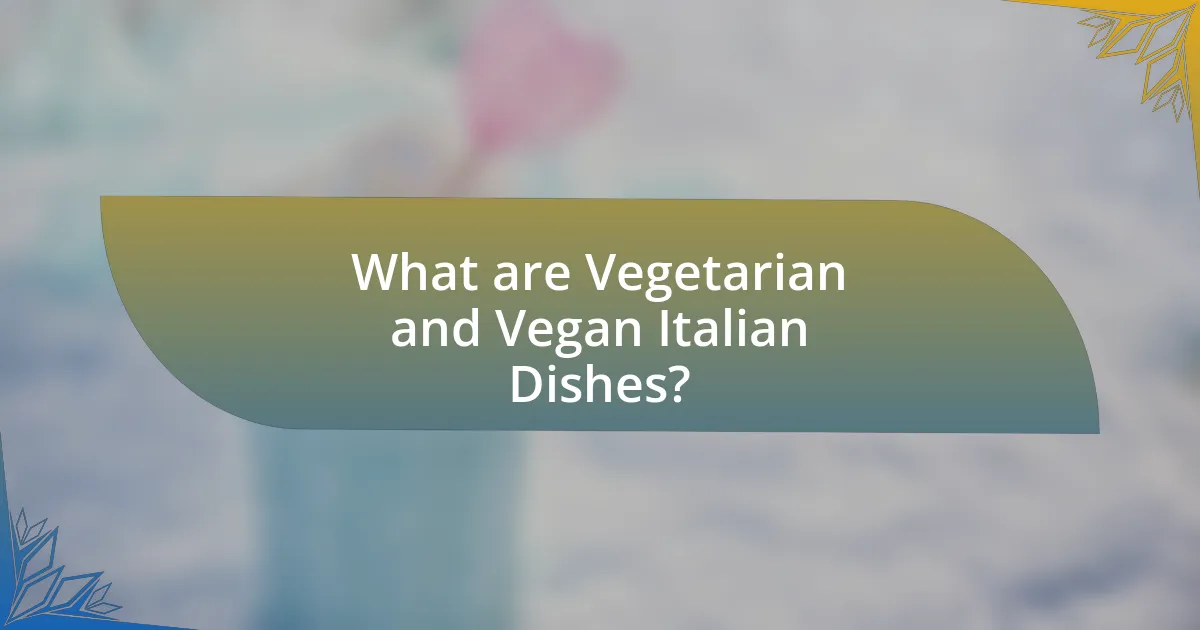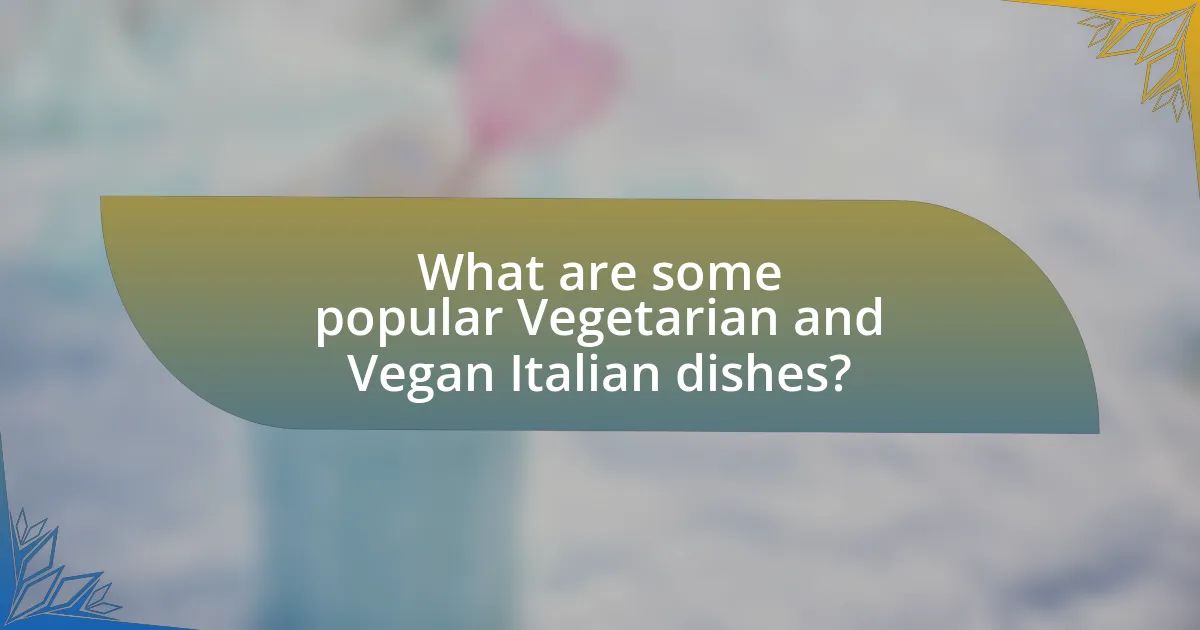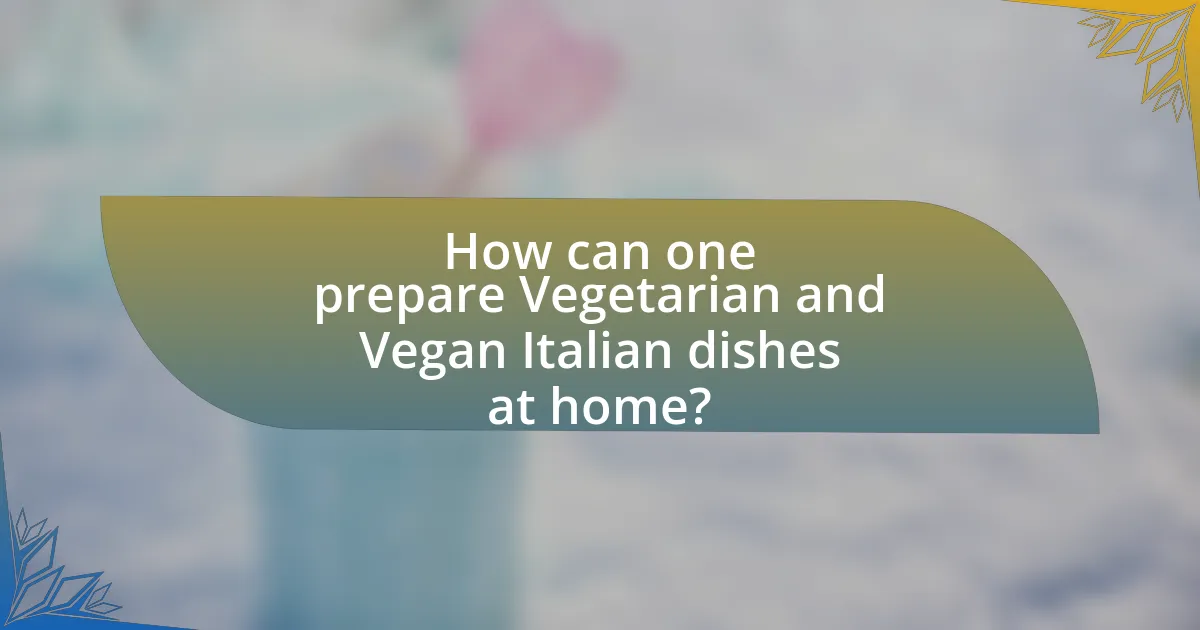The article explores vegetarian and vegan Italian dishes, highlighting popular options such as Caprese salad, pasta primavera, and risotto made with plant-based ingredients. It outlines the differences between vegetarian, vegan, and traditional Italian cuisine, emphasizing the use of fresh vegetables, herbs, and high-quality olive oil to enhance flavors. The growing interest in these plant-based diets is attributed to health benefits and environmental awareness, leading to innovative adaptations of classic recipes. Additionally, the article discusses essential cooking techniques, recommended tools, and tips for balancing flavors and textures in vegetarian and vegan Italian meals.

What are Vegetarian and Vegan Italian Dishes?
Vegetarian and vegan Italian dishes include options such as Caprese salad, which features fresh tomatoes, basil, and mozzarella (for vegetarians), and pasta primavera, made with seasonal vegetables and olive oil. Vegan alternatives can include dishes like spaghetti aglio e olio, which consists of pasta, garlic, and olive oil, and risotto made with vegetable broth and mushrooms. These dishes highlight the use of fresh ingredients and traditional cooking methods, making them flavorful and satisfying. The popularity of vegetarian and vegan diets has led to an increase in these options in Italian cuisine, reflecting a broader trend towards plant-based eating.
How do Vegetarian and Vegan diets differ from traditional Italian cuisine?
Vegetarian and vegan diets differ from traditional Italian cuisine primarily in their exclusion of animal products. Traditional Italian cuisine often features meat, fish, dairy, and eggs as central components, such as in dishes like lasagna, risotto, and various pasta sauces that include meat or cheese. In contrast, vegetarian diets eliminate meat and fish but may include dairy and eggs, while vegan diets exclude all animal-derived ingredients. This fundamental difference leads to variations in ingredient selection and preparation methods, with vegetarian and vegan Italian dishes relying on plant-based ingredients like vegetables, legumes, grains, and plant-based cheeses to create flavorful alternatives.
What ingredients are commonly used in Vegetarian and Vegan Italian dishes?
Common ingredients in Vegetarian and Vegan Italian dishes include tomatoes, garlic, olive oil, basil, and various vegetables such as zucchini, eggplant, and bell peppers. These ingredients form the foundation of many traditional Italian recipes, providing rich flavors and textures. For instance, tomatoes are essential in sauces like marinara, while garlic and olive oil are staples in dressings and sautéed dishes. Additionally, herbs like oregano and parsley enhance the taste, making these dishes both flavorful and satisfying.
How do these ingredients enhance the flavors of Italian cuisine?
Ingredients such as fresh herbs, ripe tomatoes, and high-quality olive oil significantly enhance the flavors of Italian cuisine. Fresh herbs like basil and oregano provide aromatic depth and complexity, while ripe tomatoes contribute natural sweetness and acidity, essential for balancing flavors in sauces. High-quality olive oil adds richness and a fruity note, elevating the overall taste profile of dishes. The combination of these ingredients creates a harmonious blend that is characteristic of authentic Italian cooking, as evidenced by traditional recipes that emphasize their use for optimal flavor development.
Why is there a growing interest in Vegetarian and Vegan Italian dishes?
There is a growing interest in Vegetarian and Vegan Italian dishes due to increasing health consciousness and environmental awareness among consumers. Studies indicate that plant-based diets can reduce the risk of chronic diseases, prompting many to seek healthier alternatives. Additionally, the environmental impact of meat production has led to a shift towards sustainable eating practices, with a significant rise in the demand for vegetarian and vegan options in Italian cuisine. According to a report by the Plant Based Foods Association, the plant-based food market has grown by 27% in recent years, reflecting this trend.
What health benefits are associated with Vegetarian and Vegan diets?
Vegetarian and vegan diets are associated with numerous health benefits, including lower risks of heart disease, hypertension, type 2 diabetes, and certain cancers. Research published in the Journal of the American Heart Association indicates that plant-based diets can significantly reduce cholesterol levels and improve heart health due to their high fiber content and low saturated fat levels. Additionally, a study in the American Journal of Clinical Nutrition found that individuals following vegetarian or vegan diets tend to have lower body mass indexes (BMIs) and better weight management, which contributes to overall health. These diets are also rich in essential nutrients, such as vitamins, minerals, and antioxidants, which support immune function and reduce inflammation.
How do cultural trends influence the popularity of these dishes?
Cultural trends significantly influence the popularity of vegetarian and vegan Italian dishes by shaping consumer preferences and dietary choices. For instance, the rising awareness of health and environmental issues has led to an increased demand for plant-based diets, with a 300% growth in veganism reported in the U.S. from 2004 to 2019, according to a study by The Vegan Society. This shift in consumer behavior drives restaurants and food brands to innovate and offer more vegetarian and vegan options, making these dishes more mainstream and accessible. Additionally, social media platforms amplify food trends, showcasing vibrant plant-based dishes that attract attention and encourage adoption among diverse demographics.

What are some popular Vegetarian and Vegan Italian dishes?
Popular vegetarian and vegan Italian dishes include Caprese salad, which features fresh tomatoes, basil, and mozzarella, and can be made vegan by omitting cheese. Another dish is Pasta Primavera, a mix of seasonal vegetables and pasta, often prepared with olive oil and garlic. Risotto, particularly Mushroom Risotto, is also a favorite, made creamy with vegetable broth instead of meat stock. Additionally, Eggplant Parmesan can be adapted for vegans by using cashew cheese or nutritional yeast instead of dairy cheese. These dishes highlight the rich flavors of Italian cuisine while accommodating vegetarian and vegan diets.
What are the key characteristics of classic Vegetarian Italian dishes?
Classic Vegetarian Italian dishes are characterized by the use of fresh, seasonal vegetables, herbs, and grains, often highlighting the natural flavors of the ingredients. These dishes typically feature staples such as tomatoes, eggplants, zucchini, and leafy greens, which are commonly found in traditional Italian cuisine. Additionally, classic vegetarian recipes often incorporate olive oil, garlic, and a variety of herbs like basil and oregano to enhance flavor. The emphasis on simplicity and quality of ingredients reflects the Italian culinary philosophy, where fewer components are used to create rich, satisfying meals. For example, dishes like Caprese salad and Ratatouille showcase the vibrant colors and tastes of vegetables, while pasta dishes often include vegetable-based sauces, such as marinara or pesto, that are both flavorful and nutritious.
How are traditional recipes adapted for Vegetarian diets?
Traditional recipes are adapted for vegetarian diets by substituting meat and animal products with plant-based ingredients. For instance, in Italian cuisine, dishes like lasagna can be modified by using vegetables such as spinach, zucchini, or mushrooms in place of meat, while ricotta or tofu can replace cheese for a dairy-free option. Additionally, sauces may be enriched with legumes or nuts to maintain protein content and flavor. This adaptation not only preserves the essence of traditional recipes but also caters to the nutritional needs of vegetarians, as evidenced by the increasing popularity of vegetarian versions of classic dishes in restaurants and cookbooks.
What are some examples of popular Vegetarian Italian dishes?
Popular vegetarian Italian dishes include Caprese salad, Eggplant Parmesan, and Risotto alla Milanese. Caprese salad features fresh mozzarella, tomatoes, and basil, highlighting the simplicity of Italian cuisine. Eggplant Parmesan consists of layers of breaded and fried eggplant, marinara sauce, and cheese, baked to perfection. Risotto alla Milanese is a creamy rice dish flavored with saffron, showcasing the rich culinary traditions of Italy. These dishes are widely recognized and celebrated for their flavors and ingredients, making them staples in vegetarian Italian cuisine.
What are the standout Vegan Italian dishes?
Standout Vegan Italian dishes include Vegan Risotto, Vegan Pasta Primavera, and Vegan Caprese Salad. Vegan Risotto is made with Arborio rice, vegetable broth, and various vegetables, providing a creamy texture without dairy. Vegan Pasta Primavera features seasonal vegetables sautéed with olive oil and garlic, tossed with pasta for a fresh, vibrant meal. Vegan Caprese Salad substitutes traditional mozzarella with plant-based cheese or avocado, combined with fresh tomatoes and basil, offering a classic Italian flavor profile without animal products. These dishes highlight the versatility and richness of Italian cuisine while adhering to vegan principles.
How do Vegan dishes maintain the essence of Italian flavors?
Vegan dishes maintain the essence of Italian flavors by utilizing traditional ingredients and techniques that replicate the taste and texture of classic Italian cuisine. For instance, plant-based alternatives such as cashews and nutritional yeast can mimic the creaminess of cheese, while herbs like basil, oregano, and garlic provide authentic Italian aromas and flavors. Additionally, the use of tomatoes, olive oil, and balsamic vinegar, which are staples in Italian cooking, ensures that vegan dishes retain the characteristic taste profile of Italian cuisine. Studies have shown that flavor compounds in herbs and spices can evoke similar sensory experiences, reinforcing the authenticity of vegan Italian dishes.
What are some innovative Vegan Italian recipes to try?
Some innovative Vegan Italian recipes to try include Vegan Mushroom Risotto, which uses arborio rice and vegetable broth, and Vegan Pesto Pasta, made with basil, nutritional yeast, and walnuts instead of cheese. Another option is Vegan Eggplant Parmesan, where breaded and baked eggplant slices replace traditional cheese layers. Additionally, Vegan Tiramisu can be created using coconut cream and espresso-soaked ladyfingers made from almond flour. These recipes showcase the versatility of plant-based ingredients while maintaining authentic Italian flavors.

How can one prepare Vegetarian and Vegan Italian dishes at home?
To prepare Vegetarian and Vegan Italian dishes at home, one can utilize plant-based ingredients such as vegetables, legumes, grains, and dairy alternatives. For example, a classic dish like pasta primavera can be made by sautéing seasonal vegetables like zucchini, bell peppers, and cherry tomatoes in olive oil, then tossing them with cooked pasta and fresh herbs.
Additionally, vegan risotto can be created using Arborio rice, vegetable broth, and mushrooms, which provide a creamy texture without dairy. The use of nutritional yeast can add a cheesy flavor to various dishes, enhancing the overall taste.
These methods align with traditional Italian cooking while ensuring the meals are vegetarian or vegan, showcasing the versatility of plant-based ingredients in Italian cuisine.
What essential cooking techniques are needed for these dishes?
Essential cooking techniques needed for vegetarian and vegan Italian dishes include sautéing, roasting, and simmering. Sautéing is crucial for developing flavors in vegetables and aromatics, while roasting enhances the natural sweetness of ingredients like bell peppers and eggplants. Simmering is important for creating rich sauces, such as marinara or pesto, by allowing flavors to meld together. These techniques are foundational in Italian cuisine, ensuring that the dishes are both flavorful and satisfying.
How can one effectively substitute traditional ingredients with plant-based options?
One can effectively substitute traditional ingredients with plant-based options by identifying equivalent flavors and textures in plant-based foods. For example, using cashews blended with nutritional yeast can mimic the creaminess and flavor of cheese in Italian dishes. Additionally, lentils or chickpeas can replace ground meat in recipes like Bolognese sauce, providing protein and a hearty texture. Research indicates that plant-based diets can offer similar nutritional benefits as traditional diets while reducing environmental impact (Willett et al., 2019, “Food in the Anthropocene: the EAT-Lancet Commission on healthy diets from sustainable food systems,” The Lancet). This demonstrates that effective substitutions not only maintain the essence of traditional dishes but also promote sustainability.
What cooking tools are recommended for preparing Vegetarian and Vegan Italian meals?
Recommended cooking tools for preparing Vegetarian and Vegan Italian meals include a high-quality chef’s knife, cutting board, vegetable peeler, and a set of measuring cups and spoons. A chef’s knife is essential for efficiently chopping vegetables and herbs, while a cutting board provides a stable surface for food preparation. A vegetable peeler is useful for preparing ingredients like zucchini or carrots for dishes such as pasta or salads. Measuring cups and spoons ensure accurate ingredient quantities, which is crucial for achieving the desired flavors in Italian cuisine. These tools facilitate the preparation of various vegetarian and vegan dishes, enhancing the cooking experience and ensuring successful meal outcomes.
What tips can enhance the cooking experience for Vegetarian and Vegan Italian dishes?
To enhance the cooking experience for Vegetarian and Vegan Italian dishes, focus on using fresh, high-quality ingredients, as they significantly impact flavor and texture. Fresh vegetables, herbs, and grains provide essential nutrients and vibrant tastes that elevate the dishes. Incorporating traditional Italian flavors, such as garlic, basil, and olive oil, can also enhance authenticity and satisfaction. Additionally, experimenting with plant-based alternatives to cheese, like cashew or almond-based products, can replicate creamy textures without dairy. Studies show that using seasonal produce not only improves taste but also supports local agriculture, making the cooking experience more sustainable and enjoyable.
How can one balance flavors and textures in these dishes?
To balance flavors and textures in vegetarian and vegan Italian dishes, one should incorporate a variety of ingredients that complement each other. For instance, combining creamy elements like cashew cream with crunchy toppings such as toasted pine nuts creates a pleasing contrast. Additionally, using herbs and spices, such as basil and oregano, enhances flavor depth while balancing the dish’s overall profile. The use of acidic components, like lemon juice or balsamic vinegar, can brighten flavors and cut through richness, ensuring a well-rounded taste experience. This approach aligns with culinary principles that emphasize the importance of contrasting textures and harmonious flavors, which are essential in Italian cuisine.
What are some common mistakes to avoid when cooking Vegetarian and Vegan Italian meals?
Common mistakes to avoid when cooking Vegetarian and Vegan Italian meals include neglecting to balance flavors, using low-quality ingredients, and overlooking traditional cooking techniques. Balancing flavors is crucial; for instance, failing to incorporate acidity from tomatoes or lemon can result in bland dishes. Using low-quality ingredients, such as subpar olive oil or canned tomatoes, diminishes the overall taste, as high-quality ingredients are essential in Italian cuisine. Additionally, overlooking traditional cooking techniques, like properly sautéing garlic or onions, can lead to a lack of depth in flavor, which is vital for authentic Italian dishes.















